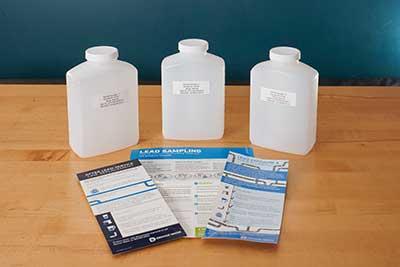Determining your service line material
Because property owners, not Denver Water, own water service lines, details about the material of an individual property’s service line have been inconsistent and scattered among a variety of sources.
Denver Water and its contractors are employing a variety of investigative methods to confirm the material of a service line as part of our publicly-accessible inventory. The inventory continues to be refined as more information is gathered through the methods outlined below.
What you need to know
- Denver Water maintains a public inventory showing the latest information about the material of all service lines in its service area.
- Investigative methods include records analysis, water testing, interior inspections of a service line connection and exterior inspections of the service line in the ground.
- Any one investigative method can prove the presence of lead, and we are required to use multiple methods to prove the absence of lead.
- Many times, property owners believe they have replaced their full service line. While this may be true, a multi-step process to ensure no lead left behind is required before a property can be removed from the program.
- Denver Water can use your help. Complete a service line material evaluation on your own. Use our service line self-reporting tool to walk through how to locate your service line and determine the material through a scratch test. Detailed instructions with example photos are included at each step.
Records analysis
Most of the available information on service line material at the start of the program included property records and information on the date for when a service line was connected to Denver Water’s main in the street. In Denver Water’s experience, homes built before 1951 are more likely to have lead service lines, but in some rare cases lead service lines may be present in homes built after 1951.
Adequate documentation from property owners, such as a contractor receipt, showing that a service line has previously been replaced in full (from the main to meter and meter to home) can also be used to confirm service line material.
Water testing
Having a lead service line doesn’t necessarily mean you have elevated levels of lead in your water. However, water testing is a simple method for customers to identify potential risks of lead exposure. We may send you a FREE water test kit if we suspect your property may have a service line containing lead.
The water test kit for single-family properties will contain three collection bottles, and the water test kit for multi-family properties will contain one collection bottle. It is important to collect water samples by closely following the instructions provided with the kit, and return the samples, free of charge, within 48 hours of collection to obtain accurate results.
Visual observation (interior)
In addition to water testing, Denver Water may request to inspect the water service line at the point of entry into the home. This will require an appointment where the resident can provide access to the entry point into the property. In some cases, this may be behind appliances or furniture that will need to be moved before the appointment. The access point may also be in a crawl space or behind a wall.
In some situations, a copper service line may have been partially installed either from the street to the water meter or from the meter to the house. Along with potholing, described below, this visual observation can confirm the material present at specific points along the service line.
Visual observation (exterior) — Potholing
A pothole inspection helps determine the material type of the water service line.
Before the inspection, the contractor will request locates on utility lines, which will be marked with paint or flags before the inspection. The contractor will then excavate two holes, typically one in the street and one in the yard between the meter and building, so that the line can be inspected. This includes a visual inspection, photographs, magnetic and scratch tests, if necessary, and documentation. Additional potholes may be needed to confirm service line material if initial potholing and other investigative methods do not show the presence of lead. The holes are restored following the inspection.
The potholing process takes place outside of the property or building. Whenever possible, we ask a property owner or representative to be on-site during the inspection so we can also conduct the interior inspection of the service line as it enters the home or building.
What the investigation tells us
Denver Water may use one or all of the investigative methods to confirm the presence of a water service line containing lead. Any one of these methods may confirm the presence of lead, but it takes a combination of these methods to confirm the absence of lead.
If it is confirmed that a property has a lead service line, the property will remain enrolled in the Lead Reduction Program.
If it is confirmed that your water service line is made of copper or material other than lead, you will receive a letter confirming your removal from the program.




